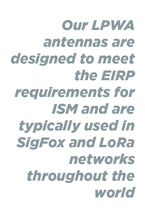Among the multitude of attention and discussion that surrounds the Internet of Things (IoT), the subject of antenna performance is not always properly considered. Sometimes, this lack of attention is driven by certain interpretations of IoT, based on which of several low cost devices are close to each other with no need for powerful transceivers. Even in those scenarios, antenna performance remains very important because of issues such as noise, fading and the need for efficiency. Therefore, antennas are an essential element for the IoT.
In order to understand about antennas for the IoT, Saverio Romeo, the principal analyst for Internet of Things, wearable technologies, smart solutions and IoT policy at Beecham Research, met Sifiso Gambahaya, the engineering manager and senior antenna engineer EMEA for Taoglas Antenna Solutions. Taoglas is a well known advanced antenna products and RF service provider. The company is headquartered in Ireland, but has global coverage with design centres in Germany, Taiwan and the USA, the latter two locations also house the production facilities
Saverio Romeo: I’m raising what is probably an obvious question, but why is antenna performance important for the Internet of Things?
Sifiso Gambahaya: There are several answers to this question. However, an example of an IoT application can help explain the situation. Currently, smart metering is a very popular application in the IoT market. Smart metering projects involve large deployments of smart meters. For smart metering, efficiency and the radiation pattern of the antenna at both the meter side and the base station side define how many smart meters one base station can cover. With Taoglas’ solutions you can use less base stations to build out your wireless smart meter network, and your smart meter points themselves have more reliable reception, especially in challenging areas such as basements or in water pits. Taoglas solutions can also guarantee high performance in different contexts, in sparse rural areas as well as in densely populated urban areas.
 SR: How would you describe Taoglas’ offering for IoT?
SR: How would you describe Taoglas’ offering for IoT?
SG: We cover all the needs in terms of forms of wireless connectivity. For example, in the case of cellular communications, our PA.25A Anam is a compact and robust SMD PIFA 2G/3G hexa-band antenna, offering superb efficiency of up to 69% in a tiny form factor of just 35x6x5mm. The latest extension to the Anam series, the PA26.A, also covers the 4G LTE bands. For terminal mount solutions within the 4G bands we offer the patent pending TG.35.8113 Apex II. This hinged ultrawideband dipole antenna is designed to cover all cellular, ISM and Wi-Fi frequencies between 698- 6000MHz and is ground plane independent. It achieves efficiencies of up to 84% and is an ideal solution for any device requiring high and reliable performance. We also offer a range of flexible PCB antennas, which can adhere directly to glass and plastic surfaces. Our Pantheon and Spartan ranges of wideband MIMO LTE external antennas can also be used for smart-metering solutions. These antennas are designed to be mounted on a flat ground plane or pole mounted on a metal bracket.
SR: LPWAN technologies are currently defining the low data IoT space. What do you offer for those technologies?
SG: Our LPWA antennas are designed to meet the EIRP requirements for ISM and are typically used in SigFox and LoRa networks throughout the world. In fact, we have the largest market share for smart meter LTE embedded antennas on the market in the U.S. and have world class test facilities in San Diego. Our omni-directional helical antenna, the HA.10, is a quarter wave monopole offering, operating at 169MHz, while our FXP280 is a flexible circuit antenna which operates at 868MHz, a frequency which is flexible enough to fit a multitude of designs.
Our terminal mount omni-antennas, ideal for base stations, deliver maximum coverage across these networks and provide peak gain of between 3- 12dbi. Our first to market OMB.868.B12F21 Barracuda is an omni-directional IP65 waterproof, outdoor antenna providing peak gain of 12dbi operating at the 868MHz band. This UV resistant fibreglass antenna provides the largest coverage area for Low Power Radio and mesh networks and its robust frame means it is ideal for harsh weather.
SR: Smart metering and smart utility are frequent terms in your descriptions. Are those key IoT application areas of interest for Taoglas?
SG: Taoglas has plenty of experience in a variety of IoT applications including telematics, automotive, wearables, medical devices, remote monitoring and in applications such as highspeed video broadcasting. However, at the moment, we see a strong attention on smart metering in the market place. Therefore, we provide an extensive range of terminal and embedded smart metering solutions across the LTE and the LPWA bands. These embedded and terminal mounted antennas are used on the end customer side in areas such as an LTE router or the smart metering device itself, while larger omni-directional antennas are used as coverage antennas at the base station.
SR: Do you offer specific services to your customers such as technical support?
SG: We offer a wide range of value added services to help ensure that our utility customers make informed decisions when choosing the best antenna for their device. As part of our ISA.10 service, we review customer requirements with them to understand design priorities and to define clear performance requirements. We delve into customers’ 3D design and help choose the correct solution and suggest an efficient integration plan. Once a physical product, with our antenna, has been created we offer the ISA.12 service. This involves reviewing the transmission line design integrity as well as PCB layer stack-up. Once the design is wholly sound, we offer a testing and matching/tuning service. We offer these critical testing services as a value added services to the actual antenna products we supply.
SR: Testing is a critical aspect for antenna performance. What do you do in that regards?

We’re constantly testing our antennas and stressing them to breaking point
SG: At Taoglas, we understand the importance of reliability testing and a large number of the products mentioned are manufactured in TS16949 and ISO 9001 certified facilities and are RoHS compliant. We have four world class R&D testing facilities across our locations in Taiwan, Germany, Ireland and San Diego in the U.S. We are constantly testing our antennas for reliability and stressing them to breaking point to understand the conditions and environments that our products can withstand.
SR: Can you describe the key features of your R&D testing facilities?
SG: Our thermal chamber provides thermal cycling from -40°C to +85°C for 30 times over ten days, which follows the ISO16750 specifications. It can go up to +125°C if needed.
Our UV and salt spray test ensures our housing and product operate as designed over an extended period of time. We also test for ingress protection in an IP67 tank. In fact, we run a sequence of tests from the thermal chamber then to the vibration table and then dunk it into the IP67 tank checking the return loss at every step to ensure the product has not failed. We have a method for testing our large antennas for wind loading and an outdoor antenna mast where we mount our antennas to test for ruggedness against harsh outdoor environments to measure weather effects such as rain, wind, pollutants that can also have an impact on the product.
All five of our anechoic chambers provide passive and active testing, with ranges from 400MHz to 18 GHz. We take customers’ products and carry out full active testing, tuning and layout changes where necessary for GNSS, LTE, cellular and WiFi. We test to pre-certification levels for operator requirements such as PTCRB or AT&T Verizon.
SR: It seems that research and development is very important for Taoglas. Which are your next steps in terms of innovation?
SG: We are designing next generation 5G antennas which will be capable of supporting more devices and provide greater capacity than the current LTE MIMO antenna technologies. This will enable the connection of more devices. We are also looking at radar antennas for a variety of applications. We aim to have fully integrated radar RF front end system along with the antenna as a single solution.










